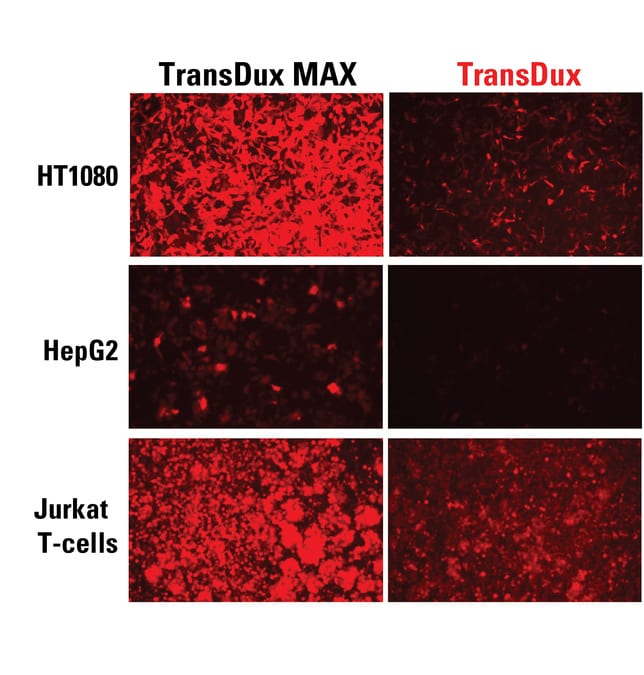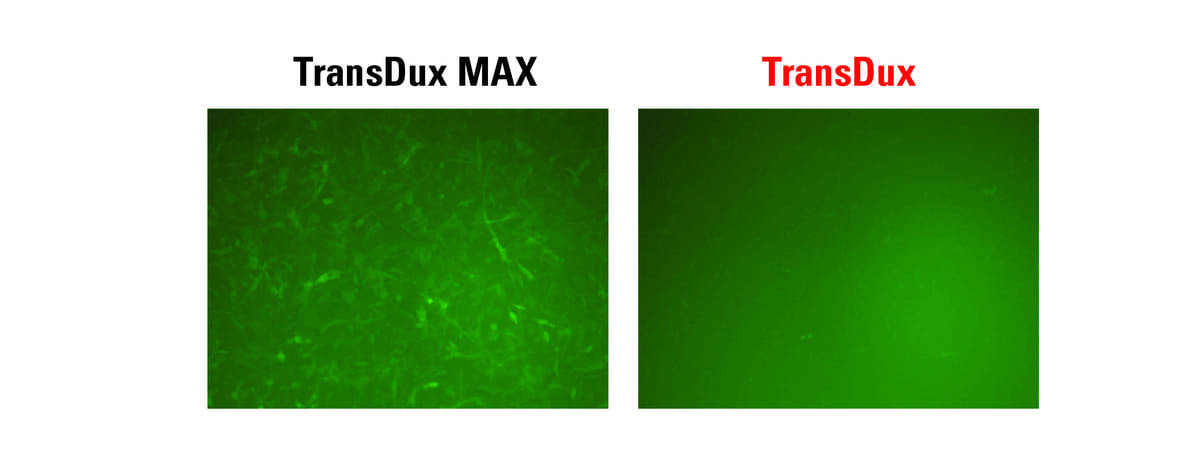TransDux™ MAX Lentivirus Transduction Reagent
- Efficient—up to 8-fold greater transduction efficiency than polybrene, and 4-fold greater efficiency than standard TransDux reagent as measured by qPCR*
- Easy-to-use—kit format requires minimal hands-on time (<5 minutes)
- Non-toxic—no need to change out media after infection
- Versatile—works with all types of packaged lentivirus
- Flexible—enhances transduction efficiency in a wide variety of cell lines
Products
| Catalog Number | Description | Size | Price | Quantity | Add to Cart | |||
|---|---|---|---|---|---|---|---|---|
| LV860A-1 | TransDux MAX Lentivirus Transduction Enhancer | 100 Transductions | $532 |
|
||||
Overview
Overview
Be confident in your gene delivery with TransDux MAX™
Whether you’re working with difficult-to-transduce cells like primary T-cells or just want to ensure high transduction efficiency, SBI’s TransDux™ reagents are ready to deliver. Our newer TransDux MAX Lentiviral Transduction Reagent can increase transduction efficiencies by up to 8-fold compared to polybrene, while our original TransDux formulation (Cat# LV850A-1) is still available for researchers who are not yet ready to make the change.
Ensure reliable and efficient gene delivery with TransDux MAX.
- Efficient—up to 8-fold greater transduction efficiency than polybrene, and 4-fold greater efficiency than standard TransDux reagent as measured by qPCR*
- Easy-to-use—kit format requires minimal hands-on time (<5 minutes)
- Non-toxic—no need to change out media after infection
- Versatile—works with all types of packaged lentivirus
- Flexible—enhances transduction efficiency in a wide variety of cell lines
- Broadly compatible—does not interfere with downstream gene expression or functional assays
*Based on infection of HT1080 cells with the pre-packaged virus format of SBI’s BLIV 2.0 reporter MSCV-Luciferase-EF1a-copGFP-T2A-Puro (Cat# BLIV713VA-1) and the appropriate conditions for polybrene, TransDux, and TransDux MAX. Virus transduction & integration efficiency was measured using SBI’s Global UltraRapid™ Titering Kit (Cat #LV961A-1)
References
How It Works
How It Works
Take your transduction efficiencies to a whole new level
TransDux MAX comes in an easy-to-use, two component format (TransDux and MAX Enhancer) good for 100 transduction reactions*. Simply mix both reagents into conditioned media from target cells (Figure 1), and infect with your lentivirus of choice for a higher level of transduction efficiency.
Figure 1. TransDux MAX has a quick and easy workflow.
*One reaction is defined as treating 500 µl of conditioned media in a single well of 24-well plate
Supporting Data
Supporting Data
Maximize transduction efficiencies with TransDux MAX
Figure 2. TransDux MAX delivers even higher transduction efficiencies than the original TransDux reagent. SBI’s BLIV713 pre-packaged lentivirus (CMV-Luciferase-EF1a-copGFP-T2A-Puro) was transduced into HT1080 cells using either TransDux MAX, TransDux, or polybrene. Cells were imaged for GFP expression 72-hours post-infection. (Left panel) Microscopy of transduced cells. (Right panel) qPCR-based quantitation of virus infectivity. TransDux MAX provides 4-fold higher infectivity than the original TransDux Reagent, and 8-fold higher infectivity than polybrene.
Figure 3. TransDux MAX delivers high transduction efficiencies across a broad range of cell types. Transduction of SBI’s LV605 pre-packaged virus (MSCV-GFP-T2A-RFP) into various cell lines (HT1080, HepG2, and Jurkat T-cells). Cells were imaged for RFP expression 72-hours post-infection. TransDux MAX clearly delivers more RFP-positive cells than TransDux in all three cell lines tested.
Figure 4. TransDux MAX works with hard-to-transduce lentivectors. Transduction of a custom lentivirus construct expressing GFP and a transgene-of-interest into HT1080 cells using either TransDux MAX (left panel) or the original TransDux reagent (right panel). Cells were imaged for GFP expression 72-hours post-infection. TransDux MAX is able to deliver transduced cells even when the lentivector is too difficult for the original TransDux reagent to transduce.
FAQs
- Efficient: up to 8-fold greater transduction efficiency than polybrene and 4-fold greater efficiency than standard TransDux reagent
- Easy-to-use: requires minimal hands-on time (<5 minutes)
- Non-toxic: no need to change out media after infection
- Versatile: works with all types of packaged lentivirus
- Flexible: enhances transduction efficiency in a wide variety of cell lines
- Mix both TransDux and MAX Enhancer reagents into conditioned media from target cells.
- Infect the cells with your lentivirus of choice.
- Observe higher transduction efficiency compared to other methods.
- Is TransDux™ MAX compatible with various cell types and lentivectors?
- Yes, TransDux™ MAX works with a wide variety of cell lines and is compatible with all types of packaged lentivirus. It also works well with hard-to-transduce lentivectors.
Documentation
Citations
Related Products
Products
| Catalog Number | Description | Size | Price | Quantity | Add to Cart | |||
|---|---|---|---|---|---|---|---|---|
| LV860A-1 | TransDux MAX Lentivirus Transduction Enhancer | 100 Transductions | $532 |
|
||||
Overview
Overview
Be confident in your gene delivery with TransDux MAX™
Whether you’re working with difficult-to-transduce cells like primary T-cells or just want to ensure high transduction efficiency, SBI’s TransDux™ reagents are ready to deliver. Our newer TransDux MAX Lentiviral Transduction Reagent can increase transduction efficiencies by up to 8-fold compared to polybrene, while our original TransDux formulation (Cat# LV850A-1) is still available for researchers who are not yet ready to make the change.
Ensure reliable and efficient gene delivery with TransDux MAX.
- Efficient—up to 8-fold greater transduction efficiency than polybrene, and 4-fold greater efficiency than standard TransDux reagent as measured by qPCR*
- Easy-to-use—kit format requires minimal hands-on time (<5 minutes)
- Non-toxic—no need to change out media after infection
- Versatile—works with all types of packaged lentivirus
- Flexible—enhances transduction efficiency in a wide variety of cell lines
- Broadly compatible—does not interfere with downstream gene expression or functional assays
*Based on infection of HT1080 cells with the pre-packaged virus format of SBI’s BLIV 2.0 reporter MSCV-Luciferase-EF1a-copGFP-T2A-Puro (Cat# BLIV713VA-1) and the appropriate conditions for polybrene, TransDux, and TransDux MAX. Virus transduction & integration efficiency was measured using SBI’s Global UltraRapid™ Titering Kit (Cat #LV961A-1)
References
How It Works
How It Works
Take your transduction efficiencies to a whole new level
TransDux MAX comes in an easy-to-use, two component format (TransDux and MAX Enhancer) good for 100 transduction reactions*. Simply mix both reagents into conditioned media from target cells (Figure 1), and infect with your lentivirus of choice for a higher level of transduction efficiency.
Figure 1. TransDux MAX has a quick and easy workflow.
*One reaction is defined as treating 500 µl of conditioned media in a single well of 24-well plate
Supporting Data
Supporting Data
Maximize transduction efficiencies with TransDux MAX
Figure 2. TransDux MAX delivers even higher transduction efficiencies than the original TransDux reagent. SBI’s BLIV713 pre-packaged lentivirus (CMV-Luciferase-EF1a-copGFP-T2A-Puro) was transduced into HT1080 cells using either TransDux MAX, TransDux, or polybrene. Cells were imaged for GFP expression 72-hours post-infection. (Left panel) Microscopy of transduced cells. (Right panel) qPCR-based quantitation of virus infectivity. TransDux MAX provides 4-fold higher infectivity than the original TransDux Reagent, and 8-fold higher infectivity than polybrene.
Figure 3. TransDux MAX delivers high transduction efficiencies across a broad range of cell types. Transduction of SBI’s LV605 pre-packaged virus (MSCV-GFP-T2A-RFP) into various cell lines (HT1080, HepG2, and Jurkat T-cells). Cells were imaged for RFP expression 72-hours post-infection. TransDux MAX clearly delivers more RFP-positive cells than TransDux in all three cell lines tested.
Figure 4. TransDux MAX works with hard-to-transduce lentivectors. Transduction of a custom lentivirus construct expressing GFP and a transgene-of-interest into HT1080 cells using either TransDux MAX (left panel) or the original TransDux reagent (right panel). Cells were imaged for GFP expression 72-hours post-infection. TransDux MAX is able to deliver transduced cells even when the lentivector is too difficult for the original TransDux reagent to transduce.
FAQs
- Efficient: up to 8-fold greater transduction efficiency than polybrene and 4-fold greater efficiency than standard TransDux reagent
- Easy-to-use: requires minimal hands-on time (<5 minutes)
- Non-toxic: no need to change out media after infection
- Versatile: works with all types of packaged lentivirus
- Flexible: enhances transduction efficiency in a wide variety of cell lines
- Mix both TransDux and MAX Enhancer reagents into conditioned media from target cells.
- Infect the cells with your lentivirus of choice.
- Observe higher transduction efficiency compared to other methods.
- Is TransDux™ MAX compatible with various cell types and lentivectors?
- Yes, TransDux™ MAX works with a wide variety of cell lines and is compatible with all types of packaged lentivirus. It also works well with hard-to-transduce lentivectors.





